Woolwich Dockyard
Woolwich Dockyard (formally H.M. Dockyard, Woolwich, also known as The King's Yard, Woolwich) was an English naval dockyard along the river Thames at Woolwich in north-west Kent, where many ships were built from the early 16th century until the late 19th century. William Camden called it 'the Mother Dock of all England'.[1] By virtue of the size and quantity of vessels built there, Woolwich Dockyard is described as having been 'among the most important shipyards of seventeenth-century Europe'.[2] During the Age of Sail, the yard continued to be used for shipbuilding and repair work more or less consistently; in the 1830s a specialist factory within the dockyard oversaw the introduction of steam power for ships of the Royal Navy. At its largest extent it filled a 56-acre site north of Woolwich Church Street, between Warspite Road and New Ferry Approach; 19th-century naval vessels were fast outgrowing the yard, however, and it eventually closed in 1869 (though a large part of the site remained in military hands for a further century). The former dockyard area is now partly residential, partly industrial, with remnants of its historic past having been restored.
| HM Dockyard, Woolwich | |
|---|---|
| Woolwich, NW Kent | |
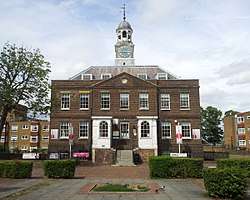 Clock House (Dockyard offices, 1783–1784), the earliest surviving building on the Woolwich Dockyard site) | |
| Coordinates | 51°29′40″N 0°3′22″E |
| Site information | |
| Operator | Royal Navy |
| Controlled by | The Navy Board (until 1832); the Admiralty (1832–1869). |
| Other site facilities | The Gun Wharf, The Ropeyard and The Steam Factory |
| Site history | |
| In use | 1512–1869 |
History
Origins
%2C_oil_on_panel%2C_Sotheby's_sale_L09635%2C_Oct._29%2C_2009.jpg)
Woolwich Dockyard was founded by King Henry VIII in 1512 to build his flagship Henri Grâce à Dieu (Great Harry), the largest ship of its day.[3] The ship was built in Old Woolwich, which is where the dockyard was initially established: past Bell Water Gate, east of the area later known as Woolwich Dockyard. The site consisted of one or more rudimentary dry docks, a long storehouse (for canvas, rigging and other materials) and a small assortment of other buildings. Like its counterpart Deptford Dockyard, Woolwich was probably chosen for its position – on the south bank of the tidal River Thames conveniently close to Henry's palace at Greenwich – and for its proximity to deep water. Several other ships were built here after Great Harry, but in the 1520s shipbuilding appears to have ceased (the site may have been prone to flooding, a problem that caused the closure of another Royal Dockyard further downstream in Erith at around this time). By 1540, however, the royal shipwrights had begun operating on higher ground further to the west at what was to become the permanent site of the Dockyard, where a pair of dry docks (already in situ and known as "Boughton's Docks") formed the centre of operations. The site was purchased by the Crown in 1546 and in the second half of the century several sizeable ships were built there. The yard was also used for heavy repair work.[2]
Early history

The two dry docks were rebuilt in the early 17th century (the first of several rebuildings) and the western dock was expanded, enabling it to accommodate two ships, end to end. In the years that followed, the dockyard was expanded; its facilities included slipways for shipbuilding, timber yards, saw pits, cranes, forges, a mast house and several storehouses. There were also houses on site for the senior officers of the yard. A clock house was built in 1670 (containing a mould loft for drawing up full-scale ship designs) and in 1698 a palatial Great Storehouse was erected. Apart from the brick-built mast house and Great Storehouse, the buildings were almost entirely of timber construction.[2]
The Gun Wharf
.jpg)
As at other Royal Dockyards, the Ordnance Office maintained a Gun Wharf at Woolwich for storage and provision of guns and ammunition for the ships based there. The Gun Wharf was sited east of Bell Water Gate (where there is now a car park next to the Waterfront Leisure Centre). It was here that Woolwich Dockyard had been founded in 1512 and the Great Harry was built in 1515; when the dockyard had moved to its new, permanent site in the 1540s, the old wharf, crane and storehouse had been given over to storage of heavy ordnance and other items. Gun carriage repair was also undertaken on site. Later, use of the Gun Wharf was shared with the nearby Royal Ropeyard, which maintained a storehouse there for hemp and other materials. The wharf and its buildings were improved and rebuilt at regular points through the 16th and 17th centuries; as late as 1664 a large new brick storehouse was provided "to lodge ships' carriages in".
The wharf was still subject to frequent flooding, however, and from the 1650s the Board of Ordnance began to make use of open land at Tower Place, to the east of the Gun Wharf, as a site for proving and storing cannons and other large guns. Known as 'The Warren', this was the beginning of what would later become the Woolwich Royal Arsenal. The Ordnance Office withdrew from Gun Wharf in 1671, but the Ropeyard continued to make use of the wharf and its associated storehouses into the 19th century.
The Ropeyard
.jpg)
In the 1570s the Crown established a naval Ropeyard in Woolwich, one of the largest in the world at the time. Too long to fit within the confines of the Dockyard, its parallel sheds lay along the line of present-day Beresford Street. As first built it consisted of a 600 ft 'cable house' along with a series of sheds accommodating different parts of the rope-making process. In 1695–1697 the ropeyard was largely rebuilt, under the supervision of Edmund Dummer; by the end of the century it included a double-ropewalk, 1061ft long, a parallel single-ropewalk of similar length, a brick storehouse with a clock tower, houses for the yard's senior officers and various other buildings, all enclosed within a perimeter wall topped by watchtowers.[2] Parts of the yard had to be rebuilt after a fire in 1759, and again after another fire in 1813. The ropeyard remained in service until 1832, by which time similar establishments in other Royal Dockyards had begun to come to the fore; the site having been sold in 1833, its buildings were demolished soon afterwards, in 1835.[4]
Second golden age
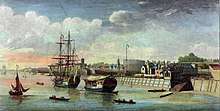
The fortunes of the yard had waned toward the end of the seventeenth century; in 1688 its work was valued at £9,669, in contrast to nearby Deptford (£15,760), not to mention the (by now much larger) Royal Dockyards at Portsmouth (£35,045), and Chatham (£44,940).[2] In the first half of the eighteenth century, however, it gained a renewed momentum: the site doubled in size, as did the workforce, and even in the first decade of the 1700s there were more ships launched from Woolwich than from any other English yard. Many buildings were built (or rebuilt) at this time, now mostly in brick. On newly acquired and reclaimed land to the east, three new slips were built and a new mast pond was created, along with adjacent mast houses and boat sheds; a sizeable rigging house was also built here. Alongside the Great Storehouse an equally large building, housing both a sail loft and a mould loft, was constructed in 1740. Meanwhile, land acquired to the west enabled a new terrace of officers' houses to be built in the early 1750s.

The yard was further expanded westwards in the 1780s, again almost doubling in size. Much of the area of the expanded dockyard was preserved as open ground for storage of timber, with rows of wooden seasoning sheds; as the Navy's ships were growing in size and number, more raw materials were needed across the Royal Dockyards. Two new mast ponds were constructed, replacing a pond at the eastern end of the site which dated from 1720 but was now considered too small (the new ponds and mast houses could accommodate mast lengths of up to 120 feet (37 m)); the old pond, together with its associated buildings, was now given over to the construction and storage of ship's boats. Centrally positioned in the expanded yard, a new clock house was built, containing offices for the various departments of the dockyard, and with it a new main gateway (replacing the old entrance which had been located further to the east).
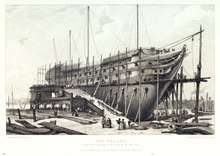
Later, Shipbuilding continued in earnest during the Napoleonic Wars; but, as ships grew still bigger, the Thames continued to silt up. In 1800 Samuel Bentham, the Inspector-General of Naval Works (who had himself served as an apprentice shipwright at Woolwich in the 1770s) proposed replacing Woolwich, Deptford, Chatham and Sheerness dockyards with a single new facility on the Isle of Grain; but this, (along with other radical proposals) was not pursued. In 1802 a steam-driven bucket dredger was brought into service at Woolwich (prior to this, convicts had been used to dredge the quayside by hand) but still the silting persisted; nevertheless, the yard continued to be developed: in 1814 a large smithery or metal-working factory was added to produce anchors and other iron items. In the 1820s two new covered slips were added (No.1 and No.2 Slips) large enough to accommodate the latest ship designs. The following decade a substantial part of the river wall was rebuilt in brick and the two dry docks were reconstructed in granite in the 1830s-40s. Alongside the docks a steam-powered saw-mill was provided, a new workshop with steam hammers and a hydraulic chain and cable testing facility.
The Steam Factory and last years of the Dockyard
From 1831, Woolwich found a new lease of life as a specialist yard for marine steam engineering (a relatively new technology which was being developed commercially at nearby Millwall). New buildings were constructed on the site for steam manufacturing and maintenance, including a boiler shop for manufacturing boilers, foundries for brass, copper and iron work, and an erecting shop for assembling the steam engines; by 1843 all were integrated into a single factory complex, with a single large chimney drawing on all the various forges and furnaces by way of underground flues.[5] Integral to the creation of the steam factory was the conversion of two mast ponds (which lay to the north of what is now Ruston Road) into steam basins, where ships could moor alongside the factory while their engines and boilers were fitted. One of these basins was provided with its own dry dock (No. 1 Dock) which, like the basins, was filled in and built over in the 20th century. The factory was part of the dockyard, but had a high degree of independence: it was accessed by its own gate (known as the West Gate or Steam Factory Gate) and overseen by its own official, the Chief Engineer.

Woolwich retained its primacy as the Navy's steam engineering yard through the 1840s, but following the establishment of large-scale steam yards at Portsmouth (1848) and Devonport (1853) it became increasingly redundant, especially as its basins were no longer large enough for the size of ships now being built. Older ships still came to Woolwich for engine repairs and maintenance, but by the end of the Crimean War the steam factory's days were numbered. Surprisingly though, the dockyard had managed to remain active in shipbuilding and its facilities continued to be upgraded and expanded through the 1850s and early 1860s; during that time a new rolling mill and an armour plate shop were built as well as a sizeable new sail loft and rigging store. Ultimately, though, the yard could not keep pace with the emerging needs of the new ironclad warships, and by 1865 it was clear that both Woolwich and Deptford Dockyards were destined for closure.[2]
Closure and aftermath
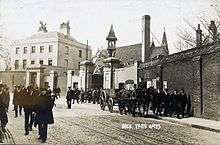
Woolwich Dockyard finally closed in 1869.[6] After closure, much of the land was retained by the War office as storage space for the Ordnance Stores Department, based at the nearby Royal Arsenal; general items (including barrack stores, accoutrements and harness) were moved to the Dockyard, while 'warlike stores' remained in the Arsenal. Warehouses were built across much of the site and existing buildings were converted to provide storage space. A narrow-gauge railway system served the complex, linked by way of a tunnel under Woolwich Church Street to the North Kent Line (which itself was linked into the Royal Arsenal Railway); the tunnel remains in situ for use by pedestrians.
In 1905 an Army Service Corps depot was established on the old Dockyard site (the Corps headquarters was nearby in Connaught Barracks).[7] During the First World War the site accommodated the country's largest Army Pay Office alongside the ordnance depot, as well as units of the Army Service Corps and the Army Ordnance Corps.[8]
In 1926 the western part of the site was sold to the Royal Arsenal Co-operative Society; the Co-Op still occupies a number of buildings on the site. The older, eastern portion of the site remained in Ministry of Defence hands, used for storage, workshops and offices, until the closure of the Royal Arsenal in the 1960s.[9] (The Royal Electrical and Mechanical Engineers, one of the last military units on site, moved out in 1966, taking with them the muster-bell and mast that had stood inside the main gate; it was re-erected at their depot at Arborfield, where it was rung for church services;[10] in 2016 it was scheduled to move with the corps to their new headquarters at MoD Lyneham.)[11]
Thereafter the older part of the dockyard was turned into a housing estate by Greenwich London Borough Council in the early 1970s. In the 1980s and 90s the Thames Path was extended to the area. Two towers with luxury apartments were built at Mast Quay around 2005, with even taller towers being projected in 2015.[2] The various housing projects have encroached on the historic character of the area.
Notable ships launched at the dockyard
_RMG_PY0845.jpg)
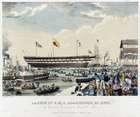

- 1512–14 – Henri Grâce à Dieu (Great Harry); flagship of Henry VIII
- 1557–59 – Elizabeth Jonas (the Elizabeth); fought against the Armada in 1559; rebuilt in 1597–98; broken up in 1618
- 1586 – Vanguard – the first Royal Navy ship to bear this name
- 1608 – Ark Royal – a rebuilding
- 1610 – HMS Prince Royal
- 1613 – Defiance – a rebuilding
- 1615 – Merhonour – a rebuilding
- 1616 – HMS Convertine – originally begun as the private warship Destiny for Sir Walter Raleigh
- 1617 – Rainbow – a rebuilding
- 1631 – HMS Vanguard – a rebuilding
- 1637 – HMS Sovereign of the Seas; first-rate ship of the line, ordered by Charles I
- 1655 – Naseby, later renamed HMS Royal Charles
- 1658 – Richard, later renamed HMS Royal James
- 1670 – HMS Saint Andrew; first-rate ship of the line, later renamed HMS Royal Anne
- 1701 – HMS Royal Sovereign; first-rate ship of the line
- 1751 – HMS Dolphin; circumnavigated the globe twice
- 1756 – HMS Royal George; first-rate ship of the line; her sinking in 1782 was one of the worst disasters in Royal Navy history – around 800 lives were lost
- 1783 – HMS Europa – 50 gun Fourth-rate, used by Joseph Whidbey and George Vancouver to conduct a survey of Port Royal, Jamaica in 1793
- 1805 – HMS Ocean; second-rate ship of the line, flagship of Lord Collingwood
- 1809 – HMS Macedonian; frigate captured by USS United States during the War of 1812
- 1814 – HMS Nelson; a 126-gun first-rate ship of the line of the Royal Navy
- 1818 – HMS Talavera; third-rate ship of the line
- 1820 – HMS Beagle; ship used on naturalist Charles Darwin's famous voyage
- 1846 – HMS Niger, ship used for trials to prove the superiority of screw propulsion
- 1852 – HMS Agamemnon, the first British battleship to be designed and built from the keel up with installed steam power
- 1854 – HMS Royal Albert, screw steamer with 131 guns
- 1868 – HMS Repulse, the last wooden battleship constructed for the Royal Navy
- 1868 – HM Floating Dry Dock 8,200 tonnes [Constructed of iron for HM Dockyard Bermuda]
Administration of the dockyard
From 1630 until 1688 the Master Shipwright was the key official at the dockyard until the introduction of resident commissioners by the Navy Board after which he became deputy to the resident commissioner. The Commissioner of the Navy at Woolwich Dockyard held a seat and a vote on the Navy Board in London. In 1748 the dockyard was managed directly by the Navy Board,. In 1832 the post of commissioner was replaced by the post of captain-superintendent, who was invested with the same power and authority as the former commissioners, "except in matters requiring an Act of Parliament to be submitted by the Commissioner of the Navy". On 5 September 1971 all Flag Officers of the Royal Navy holding positions of Admiral Superintendents at Royal Dockyards were restyled as Port Admirals.
Master shipwright, Woolwich Dockyard
_RMG_J3623.jpg)
_RMG_J3827.jpg)
_RMG_J3334.png)
Post holders include:[12]
- Peter Pett, 1630–1652
- Christopher Pett, 1652–1668
- Jonas Shish, 1668–1675
- Phineas Pett, 1675–1678
- Thomas Shish, 1678–1685
- Joseph Lawrence, 1686–1697
- Samuel Miller, 1697–1699
- William Lee, 1700–1701
- Joseph Allin, November–March 1705
- Richard Stacey, 1705–1709
- Jacob Ackworth, 1709–1714
- John Naish, 1714–1715
- John Hayward, 1715–1727
- John Hayward, 1727–1741
- John Holland, 1742–1745
- Thomas Fellowes, 1746–1752
- Thomas Slade Thomas, May 1752 – June 1752
- Adam Hayes, June 1752 – February 1753
- Edward Allin, March 1753 – December 1755
- Israel Pownoll, December 1755 – May 1762
- Joseph Harris, June 1762 – May 1767.
- William Gray, July 1767 – July 1773
- Nicholas Phillipps, 1773–1778
- George White, January–April 1779
- John Jenner, April 1779 – December 1782
- Henry Peake, December 1782 – November 1785
- Martin Ware, December 1785 – March 1787
- John Nelson, March 1787 – March 1790
- William Rule, April–August 1790
- John Tovery, 1793–1801
- Edward Sison, 1801–1816
- Henry Canham, April 1816 – July 1826
- Oliver Lang, 1826–1853
- William M. Rice, April 1853–1859
- George Turner, July 1859–1866
Commissioner of the navy at Woolwich Dockyard
Post holders included:[13][14][15][16][17]
- Baltasar St Mitchell, 1688–1702
- Henry Greenhill, 1702–1744
- Thomas Whorwood, 1744–1745
- Edward Falkingham, 1745–1746
- James Compton, 1746–1747
- William Davies, 1747–1748
- Captain Charles Cunningham, 1806–1828
Note: From 1748 to 1806 the yard was managed directly by the Navy Board. Charles Cunningham was also commissioner at Chatham in March 1828.
Captain-superintendent, Woolwich Dockyard
Post holders included:[18][19][20][21][22][23][24][25][26][27][28]
- Captain Samuel Warren, 1828–1838
- Captain Philip Hornby, 1838–1841
- Captain Sir F. A. Collier, 1841–1846
- Captain Sir James. J. G. Bremer, 1846–1848
- Captain Henry Eden, 1848–1852
Officer-of-the-ordinary, Woolwich Dockyard
Post holders included:[29]
- Lieutenant Thomas Pearse, 1825–1828
Heritage
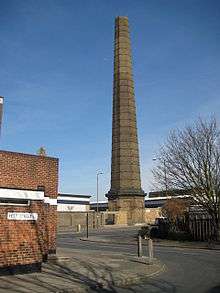
On Woolwich Church Street, a late 18th-century guard house and police office with neoclassical features stand alongside the former dockyard gates. Nearby, the former dockyard administration building now serves as the Clockhouse Community Centre; it dates from 1778 to 1784.[30] Closer to the river, a couple of closed off docks have been preserved (and partly rebuilt) as a reminder of the area's marine significance. Two shipbuilding slips have also survived, either side of the new Mast Quay apartment blocks, and a pair of antique guns have been mounted on the quayside where a Royal Marines gun battery formerly stood.[2]
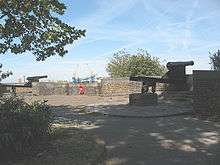
Surviving industrial buildings include parts of the old factory wall along Woolwich Church Street and remnants of the Steam Factory with its prominent chimney nearby. The original factory building of 1838 still stands on the south side of Ruston Road, although only at around two-thirds of its original length of 444 feet (135 m). When built, it housed a complex of boiler shops, a foundry, fitting shops and erecting shops for the manufacture and assembly of marine steam engines. Additions were made over the next ten years, culminating in the smithery which stands parallel with the original block, to the south; dating from 1847, this originally contained 48 hearths and 5 Nasmyth steam hammers. Coppersmiths and brass founders were accommodated in a smaller block just to the west (which is still to be seen, immediately north of the old police house at the West Gate). The building which faces the police house across the gateway was built in 1848–1849 to serve as the Woolwich Dockyard School for Apprentices: one of a number of such schools set up at the Royal Dockyards under an Admiralty Scheme of 1843, Woolwich specialised in steam engineering, and for a time factory apprentices from all the royal dockyards were educated at the school.[2]
Less than half a mile to the south of the site there is a railway station called Woolwich Dockyard.
Relocated buildings

An iron-framed building of 1814 by John Rennie the Elder, removed from Woolwich in the 1970s, was re-erected at Ironbridge where it houses the Blists Hill foundry exhibit; in the dockyard it had housed Rennie's anchor forge, which was notable as the first industrial use of steam power in any naval establishment (other than for pumping water).[5]
A number of metal roofs, built over shipbuilding slips at Woolwich in the 1840s and 1850s, were dismantled after the Yard closed and rebuilt at Chatham to house various manufacturing processes. One, built over No.4 Slip in 1846–1847 and moved to Chatham in 1876, served for many years as a boiler shop, but is now the main mall of Chatham's Dockside Outlet shopping centre. Another, dating from 1844, remains one of the earliest surviving examples of a wide-span metal frame structure, of a form destined to become familiar in the construction of train sheds and similar buildings.[2]
.jpg)
Gallery
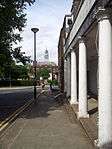 Clock house (1783) as seen from the main gate
Clock house (1783) as seen from the main gate Main Gate (1784)
Main Gate (1784) Guard house and Master Warders's lodgings (1788–1789)
Guard house and Master Warders's lodgings (1788–1789) Gun battery (1847, rebuilt 1976)
Gun battery (1847, rebuilt 1976)
Docks and slips
%2C_Woolwich.jpg) No. 2 Dock (rebuilt 1838–41)
No. 2 Dock (rebuilt 1838–41)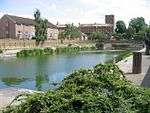 No. 3 Dock (rebuilt 1844–1846)
No. 3 Dock (rebuilt 1844–1846)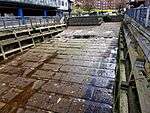 No. 5 Slip (rebuilt 1855–1856)
No. 5 Slip (rebuilt 1855–1856) No. 6 Slip (1728, later rebuilt and extended)
No. 6 Slip (1728, later rebuilt and extended)
Steam factory site
 Steam Factory: the former erecting shop (1838)
Steam Factory: the former erecting shop (1838).jpg) Steam Factory: the former brass foundry (1846) with the smithery beyond
Steam Factory: the former brass foundry (1846) with the smithery beyond.jpg) Steam Factory: the former smithery (1846)
Steam Factory: the former smithery (1846)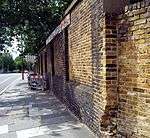 Factory wall (rebuilt c. 1840)
Factory wall (rebuilt c. 1840)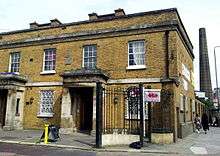 Police Station alongside the West Gate (1846)
Police Station alongside the West Gate (1846) Woolwich Dockyard School for Apprentices (1848–1849)
Woolwich Dockyard School for Apprentices (1848–1849)
Later development
 Warehouse (1914) dating from the site's use as a military store
Warehouse (1914) dating from the site's use as a military store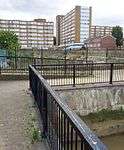 1970s housing estate
1970s housing estate Mast Quay development (2004–2006)
Mast Quay development (2004–2006)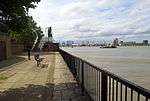 The Thames Path in Woolwich Dockyard
The Thames Path in Woolwich Dockyard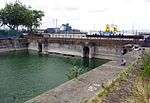 Fishing in a former dry dock
Fishing in a former dry dock
References
| Wikimedia Commons has media related to Woolwich Dockyard. |
- Hogg, Brigadier O.F.G. (1963). The Royal Arsenal Woolwich. Volume I. London: Oxford University Press.
- Saint & Guillery, The Survey of London vol. 48: Woolwich, Yale, 2012.
- Woolwich, Encyclopædia Britannica Online Library Edition, 2010
- Timbers, Ken (2011). The Royal Arsenal, Woolwich. London: Royal Arsenal Woolwich Historical Society. ISBN 978-0-9568614-0-5.
- English Heritage Survey of the Naval Dockyards
- "The Royal Dockyards of Deptford and Woolwich". Retrieved 21 August 2012.
- Osborne, Mike (2012). Defending London: the Military Landscape from Prehistory to the Present. Stroud, Gloucestershire: The History Press. p. 96.
- "Allies Here come the girls! The women volunteers at the Army Pay Office Woolwich from August to October 1914". Western Front Association. Retrieved 16 September 2016.
- "Written answers, House of Commons 1964". Hansard. Retrieved 15 September 2016.
- "Photo". Flickr.
- "The move has started..." REME Museum.
- Harrison, Simon. "Master Shipwright at Woolwich Dockyard". threedecks.org. S. Harrison, 2010–2018. Retrieved 27 June 2018.
- Harrison, Simon (2010–2018). "Woolwich Dockyard". threedecks.org. S,. Harrison. Retrieved 4 January 2019.
- Clowes, Sir William Laird (1897–1903). The royal navy, a history from the earliest times to the present Volume II. London, England: S. Low Marston. p. 231.
- Clowes, Sir William Laird (1897–1903). The royal navy, a history from the earliest times to the present Volume III. London, England: S. Low Marston. p. 4.
- Clowes, Sir William Laird (1897–1903). The royal navy, a history from the earliest times to the present Volume IV. London, England: S. Low Marston. p. 152.
- Clowes, Sir William Laird (1897–1903). The royal navy, a history from the earliest times to the present Volume V. London, England: S. Low Marston. p. 5.
- Harrison, Simon (2010–2018). "Woolwich Dockyard". threedecks.org. S,. Harrison. Retrieved 4 January 2019.
- Admiralty, Great Britain (March 1828). The Navy List. London, England: John Murray. p. 121.
- Admiralty, Great Britain (March 1834). The Navy List. London, England: John Murray. p. 136.
- Admiralty, Great Britain (March 1835). The Navy List. London, England: John Murray. p. 135.
- Admiralty, Great Britain (November 1840). The Navy List. London, England: Simpkin Marshall and Co. p. 135.
- Admiralty, Great Britain (August 1841). The Navy List. London, England: Simpkin Marshall and Co. p. 265.
- Admiralty, Great Britain (August 1843). The Navy List. London, England: Simpkin Marshall and Co. p. 263.
- Admiralty, Great Britain (February 1844). The Navy List. London, England: Simpkin Marshall and Co. p. 263.
- Admiralty, Great Britain (December 1847). The Navy List. London, England: Simpkin Marshall and Co. p. 236.
- Admiralty, Great Britain (December 1848). The Navy List. London, England: John Murray. p. 173.
- Admiralty, Great Britain (December 1852). The Navy List. London, England: John Murray. p. 185.
- Admiralty, Great Britain (March 1828). The Navy List. London, England: John Murray. p. 121.
- Pevsner, The Buildings of England – London: South. Yale, 1983 & 2002.

.jpg)
.jpg)
